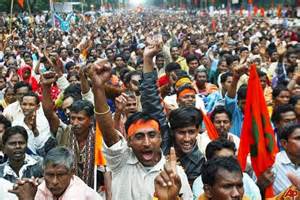RESOURCES AND INDUSTRY
India is rich in minerals, with large deposits of coal, iron ore, oil, bauxite and zinc. The mining industry has progressed during the last decades but India is still not making full use of its huge mineral resources.
India has still rich tradition of crafts.
Manufacturing has increased since it started a series of a five-year economy development plans in 1951. Factories produce now cars, sewing machines, aircraft, textiles, railway engines and ships. The biggest bicycle factory in the world is Hero Cycles of Punjab.
India has the world's largest film industry much bigger than Hollywood. It has the nickname Bollywood because it was started in Bombay (Mumbay). It produces 700 films a year in 16 languages.
India is an independent federal republic and the largest democracy in the world. It is divided into 25 states and seven union territories. Each state has his own elected assembly and government.
The president of the republic heads the national government in New Delhi but is mainly a figurehead. Decision and the law is made in the lower house (Lok Sabha). The prime minister is usual the leader of the main party.
SUCCESSION OF EMPIRES
Ashoka in 3rd century BC united India but the Empire blossomed during the 4th century AD with Gupta.
 |
| PALACE IN JAIPUR |
 |
| JODHPUR PALACE |
Then the Muslim empire followed and reached its height under Mughal emperors such as Akbar and Shah Jahan.
When the Mughal power declined Europeans went in and establish the East India Company in 1857. Revolt broke out and the British Government took over.
 |
BOMBAY GATEWAY
WHERE BRITISH ALWAYS LANDED
|
It started the independent movement and under Mahatma Gandhi rapidly increased until 1947 India became independent. After Gandhi was assassinated Pakistan and Bangladesh split away.
Ever since India has dramatically improved economically and politically. India and Pakistan had also several wars.
ELECTIONS
Elections involves huge numbers of voters, voting stations and parties. In view of over 900 millions people living in India it is not surprising.
In 1991 there were over 314million people voting in the General Election; 359 parties to vote for; 565,000 polling station were needed and manned by three million staff.




No comments:
Post a Comment